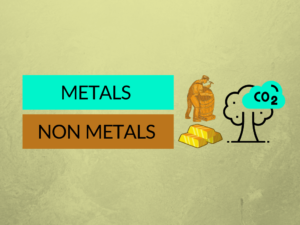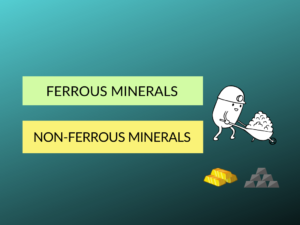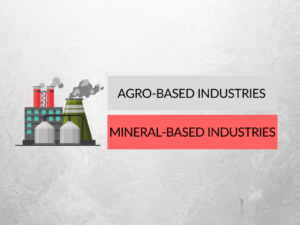There are over three thousand different minerals. Based on composition, minerals are classified mainly as
Metallic and
Non-metallic minerals
Here is what you want to know about the Difference between Metallic and Non-Metallic Minerals each having their distinct characteristics and are explained below
What are Metallic Minerals
A mineral is a commonly occurring mixture of inorganic substances. Metallic minerals are minerals that contain one or more metallic parts.
Metallic minerals include metal in raw form. Metals are hard substances that conduct heat and electricity and have a special lustre or shine. Iron ore, bauxite, manganese ore are some examples. Metallic minerals may be ferrous or non-ferrous.
Metallic minerals occur in rare, usually formed concentrations known as mineral deposits. These can consist of a variety of metallic minerals containing valuable metals such as nickel, copper, zinc, lead and gold that are used in all aspects of our daily lives.
Metallic minerals must be split apart and chemically processed to extract the useful metal from the mineral.
What are Non-Metalic minerals?
Non-metallic minerals don’t contain any metals such as Limestone, mica and gypsum are examples of such minerals. The mineral fuels like coal and petroleum are also non-metallic minerals
Non-metals are minerals that, as a rule, do not use as raw material for the extraction of metal. The group of non-metals, which are widely spread amongst the variety of minerals, is of great economic significance.
Difference Between Metallic and Non-Metallic Minerals
| Metallic Minerals | Non - Metallic Minerals |
|---|---|
| Metallic minerals are minerals that contain metals | Non-Metalic Minerals are Minerals that do not contain metals |
| Appearance | |
| Metallic minerals shine | Non- Metalic Minerals don't shine |
| Malleable | |
| Metallic minerals are Malleable | Non-Metallic minerals are non-malleable |
| Lustre | |
| These are lustre | These are non-lusture |
| Metals can be extracted by melting | These do not yield new output upon melting |
| Examples | |
| Iron=ore, manganese, copper etc | gypsum, potash, salt. etc |


Conclusion
Hence the Difference between Metallic and Non-Metallic Minerals, states that Non-metallic minerals don’t contain any metals such as Limestone, mica and gypsum are examples of such minerals while Metallic minerals include metal in raw form.
More Related Resources
Difference Between Physical Change and Chemical Change
Difference Between AC and DC





